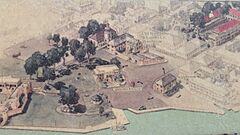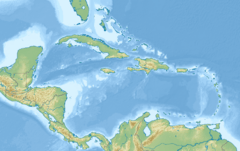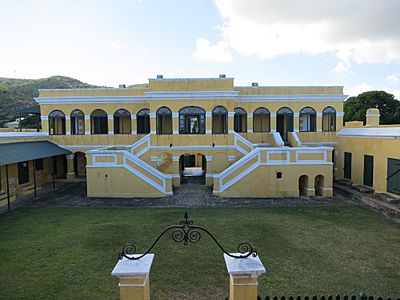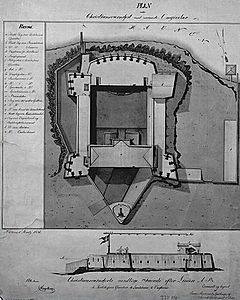Christiansted National Historic Site facts for kids
Quick facts for kids Christiansted National Historic Site |
|
|---|---|

US National Park Service marker for the Christiansted National Historic Site showing all six buildings.
|
|
| Location | Christiansted, Virgin Islands, USA |
| Area | 27.15 acres (10.99 ha) |
| Established | March 4, 1952 |
| Visitors | 106,015 (in 2005) |
| Governing body | National Park Service |
| Website | Christiansted National Historic Site |
The Christiansted National Historic Site helps us remember how towns grew in the Virgin Islands long ago. It shows off buildings from the 1700s and 1800s. These buildings are in the heart of Christiansted. This city was once the capital of the Danish West Indies on St. Croix Island.
The site includes six important old buildings. These are Fort Christiansværn (built from 1738 to 1749), the Danish West India and Guinea Company Warehouse (1749), the Church of Our Lord Sabaoth Steeple Building (1753), the Customs House (built 1840-1842), the Scale House (1856), and Government House (1747). The Danish West India and Guinea Company used its warehouse for trading enslaved people. This practice continued until 1803, when the trade was made illegal.
Contents
What is Christiansted National Historic Site?
This special place helps us understand the history of the Virgin Islands. It focuses on how towns developed during colonial times. You can see many buildings from the 18th and 19th centuries. These structures are right in the middle of Christiansted. This city was once the main city of the Danish West Indies.
A Look at the Historic Buildings
The site protects six very old buildings. Each one tells a part of the island's past.
- Fort Christiansværn: This fort was built between 1738 and 1749.
- Danish West India and Guinea Company Warehouse: Finished in 1749, this building was used for trade.
- Church of Our Lord Sabaoth Steeple Building: This church steeple was completed in 1753.
- Customs House: Built from 1840 to 1842, it was important for managing goods coming into the port.
- Scale House: This building from 1856 was where goods were weighed.
- Government House: Dating back to 1747, this was an important government building.
The warehouse was once a place where enslaved people were bought and sold. This trade was stopped in 1803.
How Christiansted Grew
Christiansted began to be planned in May 1735. It was laid out in a grid pattern, like a checkerboard. A special Building Code was created in 1747. This code set rules for street widths and how far buildings had to be from the street. It also decided what materials could be used for building. By the 1760s, most buildings were made of stone. Government buildings often showed a style called neoclassical architecture.
The Story of Fort Christiansværn
The fort was built in 1738. It stood on the remains of an older French fort that a hurricane had destroyed. The fort's main job was to protect trade ships from pirates and privateers. It also protected local people from uprisings by enslaved people. The first Danish governors lived in the fort too. British forces took control of the colony twice, from 1801 to 1803 and again from 1807 to 1815.
Later, starting in 1878, the fort became home to the police headquarters. It also held court offices, the courthouse, and important records. Soldiers were replaced by 60 police officers in 1906. These officers stayed until 1917, when the islands were transferred to the United States.
A Famous Prisoner: Alexander Hamilton's Mother
The fort also served as the colony's jail. One well-known person held there was Rachel Faucette. She was the mother of Alexander Hamilton, a famous American Founding Father. Rachel married her first husband, Johann Michael Lavien, in 1745 when she was 16. In 1750, she decided she could no longer live with him. Under Danish law, this was a reason for Lavien to have her jailed. She spent several months in a small cell, about 10 by 13 feet, with only one small window. After her release, she left for the British West Indies. There, she met Alexander Hamilton's father.
Protecting History: The National Historic Site
The site was first created on March 4, 1952. It was called the Virgin Islands National Historic Site then. Local citizens who cared about history helped make this happen. Its goal was to save the old buildings and land within its borders. It also aimed to explain the Danish way of life from 1733 to 1917. This included how the government worked, the military, trade (including the trade of enslaved people), different religions, building styles, and how crime was handled. The site was renamed on January 16, 1961. Like all historic places managed by the National Park Service, it was added to the National Register of Historic Places on October 15, 1966.
Around 2016, the National Park Service had plans to update the main warehouse. The idea was to turn it into a museum about the trade of enslaved people. They also planned to restore the area to look like it did in 1833.
Images for kids
Learn More







